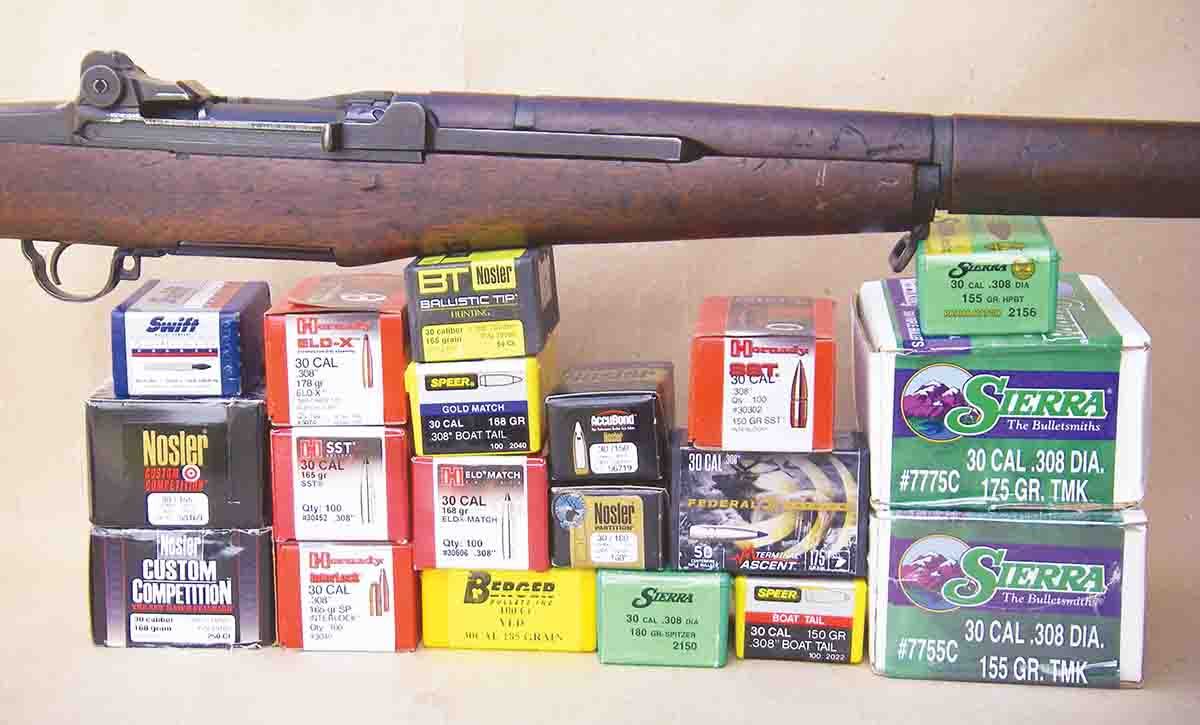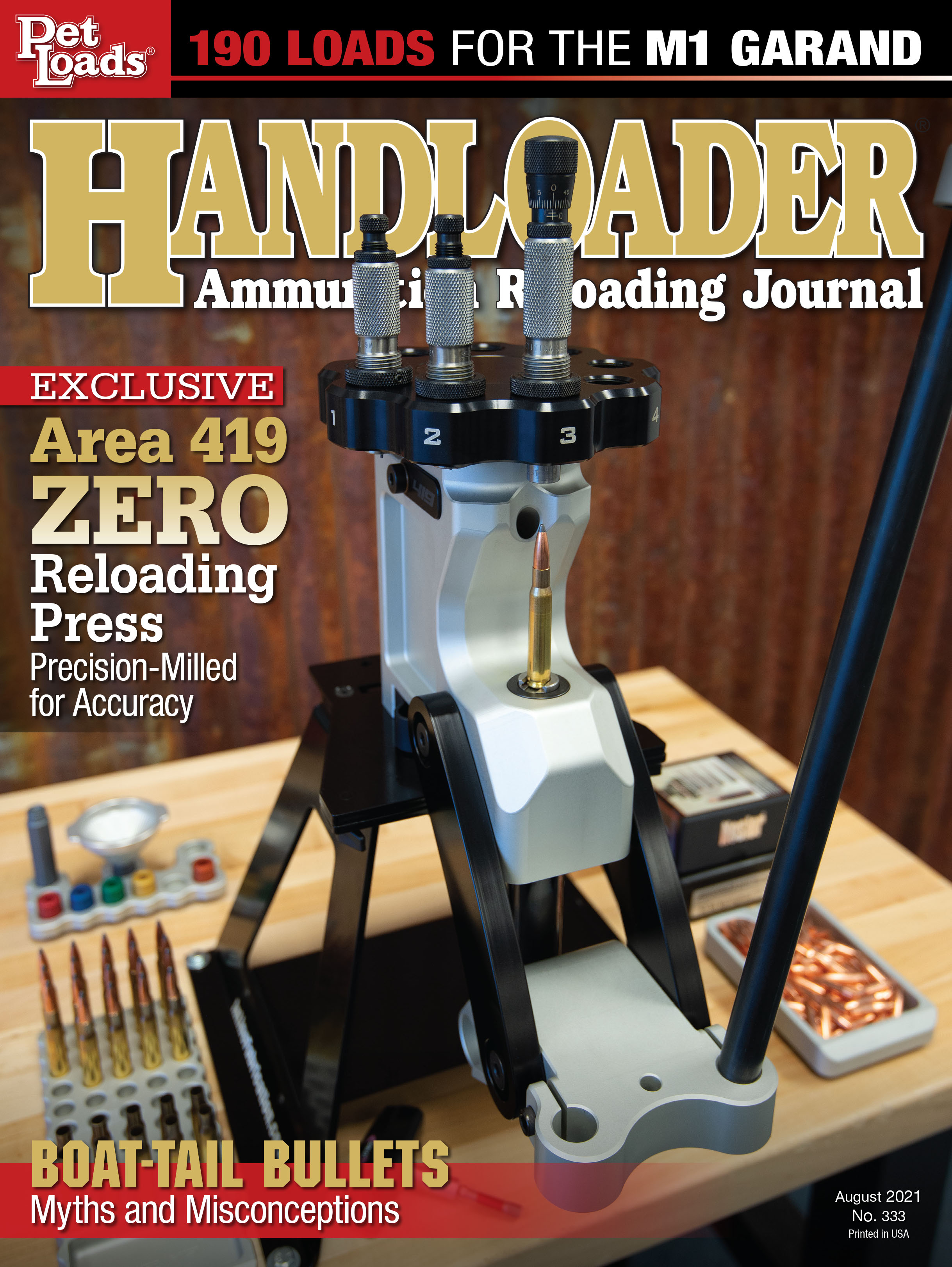U.S. Rifle, Caliber .30, M1
Pet Loads for the M1 Garand
feature By: Brian Pearce | August, 21



While most M1 Garand’s were produced by Springfield Armory, several other companies supplied guns to the U.S. military, including Winchester, Harrington & Richardson and International Harvester, while Beretta and Breda built rifles for branches of the Italian government. Argentina-based F.M.A.P. supplied a variant to its government. The private manufacturer Springfield Armory Inc., is currently producing high quality M1 Garand rifles for the civilian market. There were nearly 5.5 million M1 Garands produced for the U.S. military, many of which are currently in the hands of civilians serving as collectors pieces, but they are also used in target competition, hunting or for just plain shooting fun.
The rifle selected to develop the accompanying data was produced by H&R (Harrington & Richardson) and is a MIL-SPEC rifle without any aftermarket modifications. The bore is in high condition with minimal wear in the bore and at the throat. It is a good shooter that serves as a proper test rifle.
In developing handloads for the M1 Garand, it can be dangerous to use commonly published .30-06 Springfield data for sporting rifles. Likewise, common factory loaded “hunting” .30-06 ammunition is inappropriate and potentially dangerous. In both instances, the gas volume (not to be confused with chamber pressure) produced by these modern cartridges is in excess for the MIL-SPEC M1 Garand gas system, with port pressures becoming excessive. This can result in damage to the rifle, even permanent damage. Of even greater concern, using incorrect ammunition can be dangerous to the shooter.


Several companies offer factory loads designed for the M1 Garand, including Federal Cartridge, which lists an American Eagle 150-grain FMJ bullet at 2,740 feet per second (fps), while Hornady offers a Vintage Match load containing the 168-grain ELD Match bullet at 2,710 fps. Other companies, including PPU, offer loads designed specifically for the M1 Garand. Unfortunately, due to the huge surge for ammunition as of late, none of the above loads were available for testing at press time. For further reference, 1938-era military ammunition lists a 152-grain bullet (minimum weight 149 grains and maximum 152 grains) at 2,805 fps, which was, incidentally, propelled with IMR-4895 powder. Select loads offered in the accompanying table more or less duplicate the above factory load performance and period military loads.
Before moving forward, it is important to understand what a slam-fire is and why I am going to place so much emphasis on ammunition specifications to prevent one from occurring. A slam-fire is a situation where the cartridge that is being fed into the chamber fires without the trigger being pulled. This often occurs before the bolt is fully closed, but not always, as it can occur after the bolt locks but before the operating rod has traveled fully forward. Either way, a slam-fire often results in damage to the rifle – sometimes severe damage – but often injures the shooter.

Other potential issues with the rifle can include the sear failing, which allows the hammer to follow the bolt as it travels forward and will fire before the action locks up. Excess headspace can also contribute to a slam-fire. The bolt face and action in general should be regularly inspected for brass shavings and debris, and cleaned. Due to chambering resistance, a dirty chamber can actually be responsible for a slam-fire. Finally, it is actually a good idea to have your M1 Garand examined by a professional familiar with its design and specifications before turning it into a shooter.

When handloading for the M1 Garand, it is important to pay close attention to the details of components, cartridge specifications, etc., to prevent slam-fires, which will be discussed as I proceed.
Cases for the .30-06 vary significantly in capacity. Naturally, cases with less capacity will produce greater pressure when compared to cases that offer greater capacity. Military cases are generally thicker than any commercial cases commonly available in the U.S., and will require a reduction in powder charge weights. It is noteworthy that most military .30-06 cartridges produced prior to 1952 were corrosive primed and featured compounds that are known to deteriorate brass and compromise its strength and should not be used for handloading.
When using surplus cases manufactured after 1952, the crimped primer pocket will need to be removed before they can be used. For reference, commercial Hornady cases were used to develop all data, which averaged 177.2 grains unprimed.

A common mistake when handloading for the M1 Garand is primer selection. Again, I know match shooters that use Federal 210 Large Rifle primers and CCI BR-2 Bench Rest primers and swear by them for their shot-to-shot consistency and accuracy, and have never experienced a slam-fire. However, these primers, especially the Federal, are sensitive and easy to ignite via the floating firing pin that contacts the primer as the action slams closed, which can potentially cause a slam-fire. For this reason, I strongly recommend the CCI No. 34 primer, which is a MIL-SPEC primer designed specifically for 7.62 NATO, M14 and other automatic/semiautomatic arms. Space will not allow a detailed discussion of the engineering details of this primer; however, it is less sensitive than commercial primers and designed specifically to prevent slam-fires and meets all military specifications. It is in widespread use by the U.S. military and used by many militaries worldwide that use it in a variety of automatic weapons. Incidentally, it is a magnum primer with similar energy and ballistic performance as the CCI 250 Large Rifle Magnum primer.

Primers should always be seated at least .003 to .005 inch below flush. This assures the anvil is in contact with the bottom of the primer pocket for reliable ignition, but also prevents the primer from being slammed forward from inertia when the cartridge is chambered, which may cause a slam-fire. Cases that allow primers to be seated without resistance, or with very little resistance, may cause a slam-fire and should be crushed and discarded. This is one reason military ammunition featured primers that were crimped in place. Using a handheld priming tool will help identify primers that seat too easily.
As indicated, the M1 Garand’s gas system is designed to function with between 46.0 and 50.0 grains of powder. To achieve targeted velocities, powders with a burn rate similar to 4895 are most suitable. The fastest-burning powder used herein was Hodgdon BL-C(2), while the slowest was Vihtavuori N150. There are many excellent powders that have a burn rate that falls between those two powders. IMR-4895 and Hodgdon H-4895 both performed well and are still the go-to powder for many M1 Garand shooters. However, many newer powders are also good choices, including Hodgdon Varget, IMR-8208 XBR, IMR-4166, IMR-4064, VV-N140, VV-N150, Accurate 2520, A-4064, A-2495, Alliant Reloder 15 and AR-Comp. Each produced good accuracy and reached normal velocities for the M1 Garand.

The selection of suitable .30- caliber bullets for the M1 Garand is long; however, I generally focused on 150- through 185-grain weights, and kept powder charges within the rather tight powder volume “window” required for the rifle’s gas system. Included were match and hunting bullets, as the M1 Garand is commonly used for both purposes. While only slightly heavier than period military loads, the Nosler 155-grain Custom Competition HPBT bullet gave consistently good accuracy, while the Hornady 168-grain ELD Match likewise gave outstanding accuracy. Both are top choices for match shooters. A variety of proven hunting bullets from Hornady, Nosler and Federal were also included in the accompanying data that allow the M1 Garand to be used to hunt deer, elk and other big game for those that want to take a classic military rifle afield.

While the maximum overall cartridge length for the .30-06 is 3.340 inches, generally, bullets should be seated well off of the chamber’s leade, which serves to prevent chambering problems and helps to minimize the chance of slam-fires. They should generally be at least .040 inch off the leade; however, based on the profile of some bullet’s ogive, that figure may need to be increased to prevent chambering interference.
After bullets were seated to the desired overall cartridge length, a Lee Factory Crimp die was applied to help prevent bullets from moving while the cartridge is subjected to its rather turbulent trip into the chamber.
Many “as issued” M1 Garand’s that have little or modest bore and throat wear are capable of around MOA accuracy with select match components or high-quality handloads containing hunting bullets. Properly-accurized rifles will produce even better results.
The M1 Garand is a highly historic rifle. Both shooter interest and prices have soared over the past few years. Through proper handloading, General Patton’s “greatest battle implement” can provide reliability, accuracy and is especially fun to shoot.



.jpg)
.jpg)